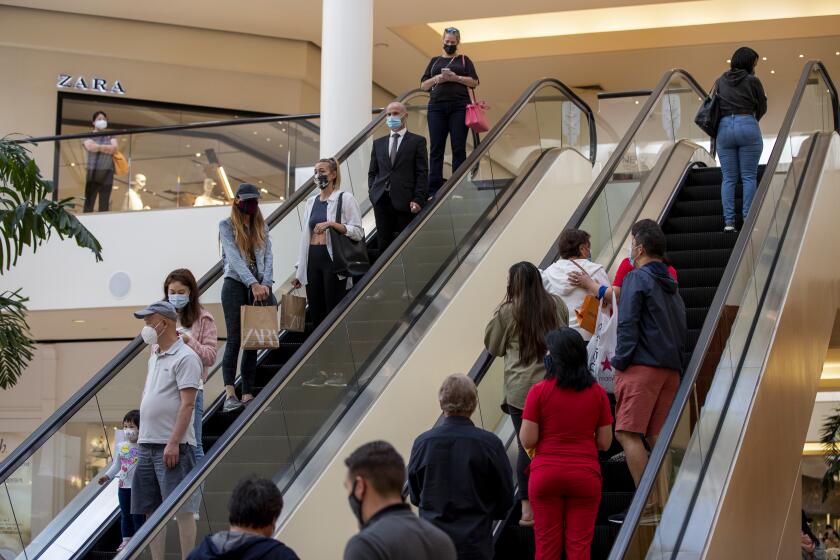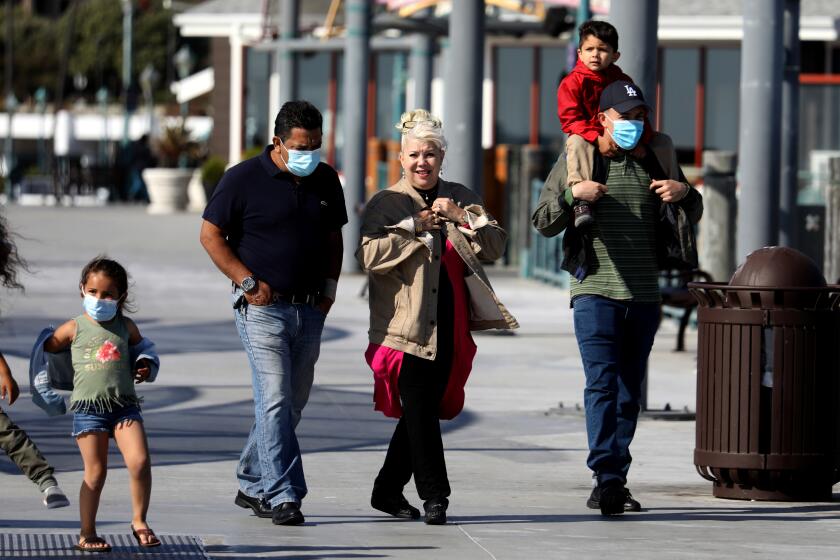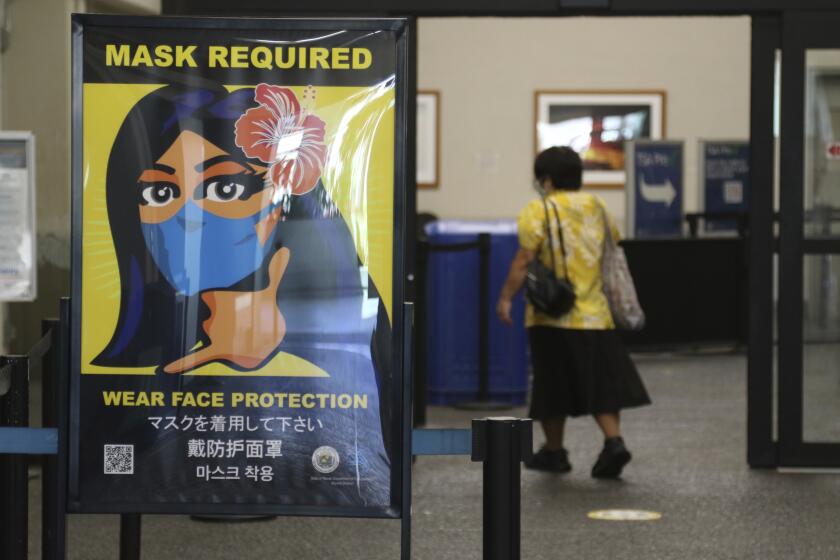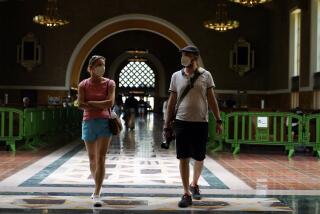Is it really safe to take off your mask? Answering your questions about CDC’s new guidance

- Share via
The Centers for Disease Control and Prevention’s guidelines to lift most mask requirements both indoors and out came as a surprise to some despite the plunging number of COVID-19 infections across the country.
Under the new guidelines, anyone who is fully vaccinated can participate in indoor and outdoor activities, large or small, without wearing a mask or physical distancing.
The changes announced Thursday don’t immediately alter the mask rules in California. But they have raised some questions.
Here are some answers:
What is the situation in California?
California has strict mask rules consistent with the CDC’s previous mask guidance, and officials said they will remain in effect at least for now as they study the new recommendations.
The state and Los Angeles County will review the federal recommendations in order to “make sensible adjustments to the orders that are currently in place,” L.A. County Public Health Director Barbara Ferrer said.
The California Division of Occupational Safety and Health’s mask-wearing requirements at businesses — including restaurants and supermarkets — remain in effect.
“Because it’s still important to protect workers at all work sites, and all work sites must follow requirements set forth by the California Division of Occupational Safety and Health, we ask that everyone continue to adhere to required distancing and masking at workplaces until Cal-OSHA changes these requirements,” Ferrer said.
It could be a week or more before substantive changes to mask-wearing orders take effect locally. Cal-OSHA next meets on May 20 to discuss statewide guidance, and county changes would not be any less restrictive than the state’s mandates.
Federal officials said more specific rules regulating masks in places such as businesses, schools and other settings where it may be hard to determine who is or is not vaccinated will probably be determined at the local level.
California’s rules, last updated May 3, generally require masks to be worn by everyone indoors whenever outside the home, with exceptions, such as when a person is outside a workplace setting and everyone indoors is vaccinated, or when there are only members of one unvaccinated household present and all have a low risk of severe complications should they get COVID-19.
Unvaccinated people also must wear masks outdoors when they can’t maintain six feet of distance from someone else. Fully vaccinated people need to wear masks in crowded outdoor settings, such as live performances, parades, fairs, festivals and sports events.
Some fear the CDC is moving too fast in lifting COVID-19 mask guidance for the vaccinated.
What about being around unvaccinated people?
If California does begin allowing fully vaccinated people to be maskless in stores, who would be checking to see if those without masks are really vaccinated? Will supermarkets really check vaccine cards at the entrance?
“There is good science to support changing our policy,” said Dr. John Swartzberg, a clinical professor emeritus of the UC Berkeley School of Public Health’s infectious diseases division. “On the other hand, I’m surprised they came out with it this soon. I would’ve liked to have had another month under my belt of seeing the numbers continue to come down.
“I can’t see grocery stores confirming that you’re vaccinated. It just won’t happen,” Swartzberg said.
The new guidance, however, works best if people follow the rules — and unvaccinated people don’t shed their masks before they’ve been fully vaccinated, which comes two weeks after the final dose of a vaccine is administered.
“I do see maybe having to show vaccination cards to get into movie theaters or restaurants,” said Dr. George Rutherford, an infectious diseases expert at UC San Francisco. “Private businesses can enforce vaccination requirements.”
It’s also unclear whether some retailers will keep their mask rules despite the CDC changes, although that appears to be the case, as representatives for Kroger, Home Depot and Starbucks say they will adhere to their current policies mandating that shoppers and employees wear face coverings.
In a momentous turn in the fight against COVID-19, federal officials are significantly easing mask guidelines as the threat of the pandemic rapidly fades.
Under CDC guidelines, when do you still need to wear a mask?
Under the federal guidance, unvaccinated or partly vaccinated people are still asked to wear masks in almost all indoor settings and most outdoor venues when interacting with people from outside their household who may not be vaccinated. (Members of a single household of unvaccinated people can be maskless indoors if everyone else is vaccinated and can go without masks at small outdoor gatherings with other unvaccinated people.)
The CDC order that requires masks to be worn by everyone traveling on public transportation, including buses and trains, and at airports and stations, remains in effect.
On Friday, however, Dr. Rochelle Walensky, director of the U.S. Centers for Disease Control and Prevention, acknowledged that more details are needed for how relaxing mask requirements indoors would realistically work in specific settings where it’s not clear who is vaccinated and who is not.
“This was a first step in our guidance. And what we really need to do now is look at each of our individual guidance for each of these individual settings in, say, in a setting of schools or childcare centers or the workplace: Is this the appropriate thing to do?” Walensky said on ABC’s “Good Morning America.”
Practically speaking, Walensky said, it would make sense that different states and counties enact different orders from the national guidelines.
“A lot of those decisions are going to have to happen at the jurisdictional level,” Walensky said.
What do experts say?
The change came as a surprise to some, even though there had been growing concern that the CDC mask rules were too strict as COVID-19 infections wane.
Experts generally supported the idea, but there were some concerns.
“I am very excited that we have reached this momentous time when those who are fully vaccinated can now get back to virtually pre-pandemic activities without concern of disease themselves,” UCLA medical epidemiologist Dr. Robert Kim-Farley said. “However, they still need to realize that if they are around unvaccinated people that may be vulnerable — the elderly, those with medical conditions — they still need to practice caution in that setting.”
UC San Francisco infectious disease specialist Dr. Monica Gandhi has been among experts who have urged the CDC to move faster to lift mask guidelines and was surprised at how fast federal officials acted Thursday. She welcomed the news and said the science backs up the new recommendations.
She said lifting mask guidance for fully vaccinated people will provide an incentive for those who may have put off getting the shot.
“People need incentives now,” Gandhi said. “I think this is going to help people who are on the fence to go and get vaccinated.”
But Dr. Leana Wen, a former health commissioner for Baltimore, worried that the CDC’s move makes it easy for people who never wanted to get vaccinated or wear masks to now enter stores without face coverings — increasing the risk for people who cannot be vaccinated, like children too young to be inoculated, or immune-compromised people who are not fully protected by the vaccine.
“We’re now putting them at risk and I think bringing us actually even further from reaching herd immunity,” Wen said on CNN.
Ferrer noted that the CDC guidelines were not released to the L.A. County Public Health Department ahead of time.
“We’re very supportive of the knowledge that the vaccines are highly protective and that people who are fully vaccinated, really, in fact, don’t need to adhere to the same safety measures as those who are not fully vaccinated,” Ferrer said.
“But it is that big question about making sure that as we’re doing this ... we don’t have an unintended consequence of creating more risk at a time when we’re really trying to move forward on the recovery journey.”
Other health experts urged caution against abandoning indoor mask mandates for vaccinated people now.
“Since we don’t know who is vaccinated and who isn’t, [it’s] reasonable to keep indoor mask mandates for a few more weeks,” tweeted Dr. Ashish Jha, dean of the Brown University School of Public Health.
The delay “allows people to finish getting vaccinated, and infection numbers to drop further,” Jha said.
The federal government is extending the requirement that travelers wear face masks on planes, trains and buses.
What about travel?
Here’s the CDC’s guidance:
Domestic travel (within the United States or to a U.S. territory)
- Fully vaccinated travelers do not need to get a SARS-CoV-2 viral test before or after domestic travel, unless testing is required by local, state or territorial health authorities.
- Fully vaccinated travelers do not need to self-quarantine after domestic travel.
- For more information, see Domestic Travel During COVID-19.
International travel
- Fully vaccinated travelers do not need to get tested before leaving the United States unless required by their destination.
- Fully vaccinated air travelers coming to the United States from abroad, including U.S. citizens, are still required to have a negative SARS-CoV-2 viral test result or documentation of recovery from COVID-19 before they board a flight to the United States.
- International travelers arriving in the United States are still recommended to get a SARS-CoV-2 viral test three to five days after travel, regardless of vaccination status.
- Fully vaccinated travelers do not need to self-quarantine in the United States after international travel.
- For more information, see International Travel During COVID-19.
The guidance allows camps to operate if all participants are fully vaccinated and outlines steps to protect those who are not fully vaccinated.
How safe are you inside a store or restaurant when you don’t know who else is vaccinated?
Dr. Anthony Fauci, the nation’s top infectious diseases expert, said customers are very safe because of the “real-world effectiveness” of the vaccines.
“That’s the reason why the CDC made that recommendation, because it became very clear that the infection rate has gone down,” Fauci said on MSNBC. “If you go into a restaurant or a store or any other place in the public indoors, you’re not going to know who’s vaccinated or not. But we felt that all things considered, given the high degree of effectiveness of the vaccines, that you’re OK to do that because your risk is very, very low.”
Although there have been some instances of breakthrough COVID-19 infections, those cases are extremely rare and account for only a fraction of the total number of fully vaccinated people in the U.S.
The CDC has reported that about .008% of those who are fully vaccinated have become infected and about 1% of them have died. Public health officials have said such cases were expected and their numbers are reassuringly few.
Will people keep wearing a mask because they don’t want to seem un-PC?
Many people are at a crossroads where they’re not quite ready to take the mask off, Fauci said.
“But I believe as the days go by — as we get a week or two into this — people are going to start feeling much more comfortable with this idea of going in an indoor situation, and if you’re vaccinated, taking the mask off.
“In every situation where you have an indoor setting, an indoor environment, it was felt by the CDC — and I agree with them — that the risk is so low that we really do need to take that step. It seems like a pretty bold step, but, in fact, the science backs it.”
More to Read
Sign up for Essential California
The most important California stories and recommendations in your inbox every morning.
You may occasionally receive promotional content from the Los Angeles Times.

















